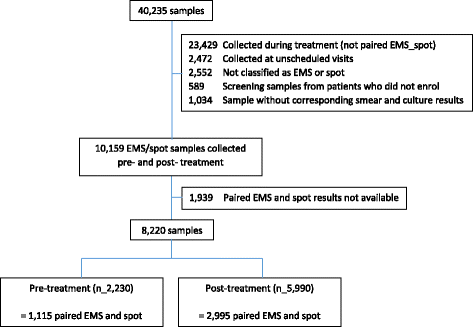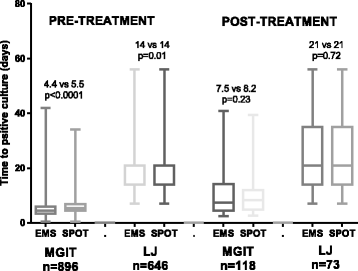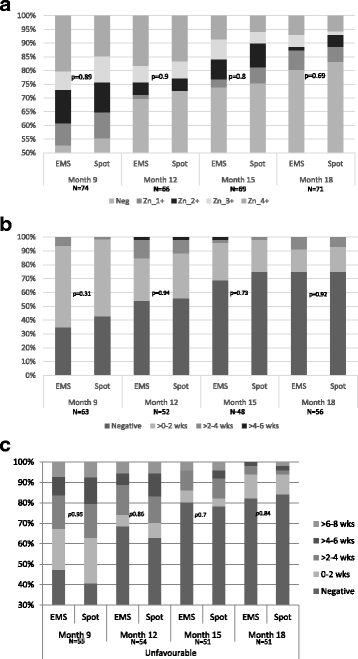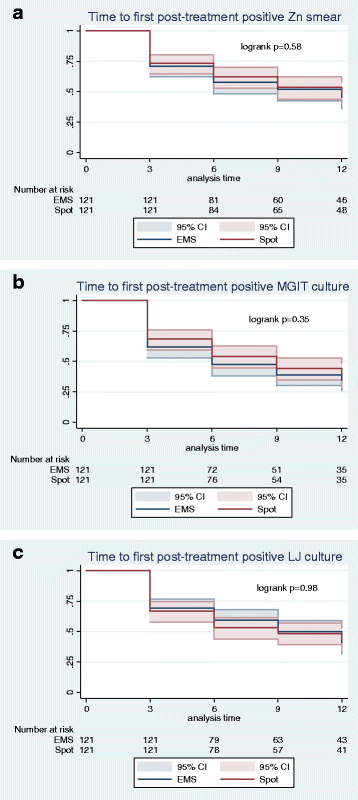Spot sputum samples are at least as good as early morning samples for identifying Mycobacterium tuberculosis
- PMID: 29073910
- PMCID: PMC5658986
- DOI: 10.1186/s12916-017-0947-9
Spot sputum samples are at least as good as early morning samples for identifying Mycobacterium tuberculosis
Abstract
Background: The use of early morning sputum samples (EMS) to diagnose tuberculosis (TB) can result in treatment delay given the need for the patient to return to the clinic with the EMS, increasing the chance of patients being lost during their diagnostic workup. However, there is little evidence to support the superiority of EMS over spot sputum samples. In this new analysis of the REMoxTB study, we compare the diagnostic accuracy of EMS with spot samples for identifying Mycobacterium tuberculosis pre- and post-treatment.
Methods: Patients who were smear positive at screening were enrolled into the study. Paired sputum samples (one EMS and one spot) were collected at each trial visit pre- and post-treatment. Microscopy and culture on solid LJ and liquid MGIT media were performed on all samples; those missing corresponding paired results were excluded from the analyses.
Results: Data from 1115 pre- and 2995 post-treatment paired samples from 1931 patients enrolled in the REMoxTB study were analysed. Patients were recruited from South Africa (47%), East Africa (21%), India (20%), Asia (11%), and North America (1%); 70% were male, median age 31 years (IQR 24-41), 139 (7%) co-infected with HIV with a median CD4 cell count of 399 cells/μL (IQR 318-535). Pre-treatment spot samples had a higher yield of positive Ziehl-Neelsen smears (98% vs. 97%, P = 0.02) and LJ cultures (87% vs. 82%, P = 0.006) than EMS, but there was no difference for positivity by MGIT (93% vs. 95%, P = 0.18). Contaminated and false-positive MGIT were found more often with EMS rather than spot samples. Surprisingly, pre-treatment EMS had a higher smear grading and shorter time-to-positivity, by 1 day, than spot samples in MGIT culture (4.5 vs. 5.5 days, P < 0.001). There were no differences in time to positivity in pre-treatment LJ culture, or in post-treatment MGIT or LJ cultures. Comparing EMS and spot samples in those with unfavourable outcomes, there were no differences in smear or culture results, and positive results were not detected earlier in Kaplan-Meier analyses in either EMS or spot samples.
Conclusions: Our data do not support the hypothesis that EMS samples are superior to spot sputum samples in a clinical trial of patients with smear positive pulmonary TB. Observed small differences in mycobacterial burden are of uncertain significance and EMS samples do not detect post-treatment positives any sooner than spot samples.
Keywords: Diagnostics; Early morning sputum; Smear microscopy; Spot sputum; Tuberculosis.
Conflict of interest statement
Ethics approval and consent to participate
The UCL ethics committee and the ethics committees of all study sites and organisations approved the REMoxTB study; these are provided in Additional file 1. Patients gave their informed consent for the REMoxTB study and for their specimens and data to be used for the purposes of this study [14].
Consent for publication
Not applicable.
Competing interests
The authors declare that they have no competing interests.
Publisher’s Note
Springer Nature remains neutral with regard to jurisdictional claims in published maps and institutional affiliations.
Figures




Comment in
-
Bringing patient-centered tuberculosis diagnosis into the light of day.BMC Med. 2017 Dec 20;15(1):219. doi: 10.1186/s12916-017-0992-4. BMC Med. 2017. PMID: 29258526 Free PMC article.
References
-
- Aspler A, Menzies D, Oxlade O, Banda J, Mwenge L, Godfrey-Faussett P, Ayles H. Cost of tuberculosis diagnosis and treatment from the patient perspective in Lusaka, Zambia. Int J Tuberc Lung Dis. 2008;12(8):928–35. - PubMed
-
- Ramsay A, Al-Agbhari N, Scherchand J, Al-Sonboli N, Almotawa A, Gammo M, Gauchan P, Yassin MA, Cuevas LE. Direct patient costs associated with tuberculosis diagnosis in Yemen and Nepal. Int J Tuberc Lung Dis. 2010;14(2):165–70. - PubMed
MeSH terms
Grants and funding
LinkOut - more resources
Full Text Sources
Other Literature Sources
Research Materials

